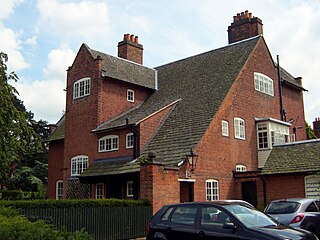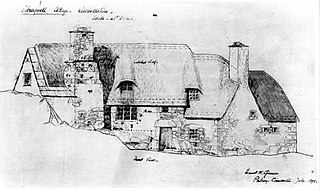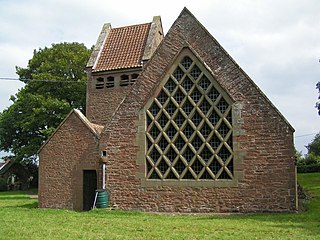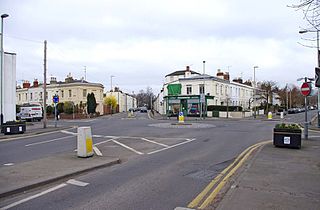
Stoneygate is part of the City of Leicester, England.

The River Frome, once also known as the Stroudwater, is a small river in Gloucestershire, England. It is to be distinguished from another River Frome in Gloucestershire, the Bristol Frome, and the nearby River Frome, Herefordshire. The river is approximately 25 miles (40 km) long.

Rodmarton Manor is a large country house, in Rodmarton, near Cirencester, Gloucestershire, built for the Biddulph family. It is a Grade I listed building. It was constructed in the early 20th century in an Arts and Crafts style, to a design by Ernest Barnsley. After Ernest's death in 1925, it was completed by Sidney Barnsley, his brother, and then by Norman Jewson, Ernest's son-in-law. All the construction materials were obtained locally, and hand worked by local craftsmen.

Ernest William Gimson was an English furniture designer and architect. Gimson was described by the art critic Nikolaus Pevsner as "the greatest of the English architect-designers". Today his reputation is securely established as one of the most influential designers of the English Arts and Crafts movement in the late nineteenth and early twentieth centuries.

Norman Jewson was an English architect-craftsman of the Arts and Crafts movement, who practised in the Cotswolds. He was a distinguished, younger member of the group which had settled in Sapperton, Gloucestershire, a village in rural southwest England, under the influence of Ernest Gimson. Surviving into old age, he brought their ideas and working methods into the second half of the twentieth century. His book of reminiscences has become established as a minor classic of the English Arts and Crafts movement. His repair of the Tudor Owlpen Manor in 1925–26 is often regarded as his most representative and successful work.

Sapperton is a village and civil parish in the Cotswold District of Gloucestershire in England, about 4.5 miles (7.2 km) west of Cirencester. It is most famous for Sapperton Canal Tunnel, and its connection with the Cotswold Arts and Crafts Movement in the early 20th century. It had a population of 424, which had reduced to 412 at the 2011 census.

Frampton Mansell is a small English village 5 miles east-south-east of Stroud, Gloucestershire, in the parish of Sapperton. It lies off the A419 road between Stroud and Cirencester. It has a prominent mid-19th century, Grade II listed church with a set of five original stained-glass windows.
Alfred Hoare Powell (1865–1960) was an English Arts and Crafts architect, and designer and painter of pottery.

Cirencester Park is a country house in the parish of Cirencester in Gloucestershire, England, and is the seat of the Bathurst family, Earls Bathurst. It is a Grade II* listed building. The gardens are Grade I listed on the Register of Historic Parks and Gardens.
Ernest and Sidney Howard Barnsley were Arts and Crafts movement master builders, furniture designers and makers associated with Ernest Gimson. In the early 20th century they had workshops at Sapperton, Gloucestershire, where both brothers are buried in the churchyard of St. Kenelm's Church.
Peter Waals, born Pieter van der Waals, was a Dutch cabinet maker associated with the Arts and Crafts movement.
Geoffrey Henry Lupton was a British architect and furniture designer who is best known for his contribution to the Arts and Crafts movement, working with Ernest Gimson and Sidney Barnsley.

The Church of St Edward the Confessor in Kempley is a Church of England parish church in the Forest of Dean district of Gloucestershire, England, close to the border with Herefordshire.

A hayrake table is a distinct pattern of table produced as part of the English Arts and Crafts movement in the early part of the twentieth century.

Stoneywell is a National Trust property in Ulverscroft, a dispersed settlement near Coalville in Charnwood Forest, Leicestershire. Stoneywell is the largest of a small group of cottages designed in the Arts and Crafts style by Ernest Gimson. It was built in collaboration with Detmar Blow in 1899 for Ernest's brother Sydney Gimson as a summer residence, and along with much original furniture, it remained in the Gimson family for over a century. As part of a highly influential vernacular movement, it has become well known within Arts and Crafts circles. In spring 2013 the National Trust announced that following a year-long appeal, it had been able to acquire the house with its Arts and Crafts contents, gardens and woodland. It was opened to the public in February 2015.
William Edward Barnsley was an English designer and maker of furniture, teacher and important figure in the 20th-century British craft movement.

Philip Clissett was a Victorian country chairmaker who influenced and inspired the English Arts and Crafts Movement through various architects and designers. His chance meeting with James MacLaren has been described as "undoubtedly a seminal point in the subsequent development of the Arts and Crafts Movement", and led to the furnishing of the meeting room of the Art Workers Guild with a large number of his chairs which can still be seen today. These chairs have been "highly influential", having been "seen by almost everyone involved in art and design from the late 1880s". They particularly influenced Ernest Gimson who, in 1890, spent six weeks with Clissett learning to make ladderback chairs. Clissett's chairs were popular with the Arts and Crafts cognoscenti, and were used by Charles Rennie Mackintosh in early commissions, and by the architectural team of Richard Barry Parker and Raymond Unwin. They were also used as part of the original furnishing of the Passmore Edwards Settlement at Mary Ward House, 5 Tavistock Place, London by the architects A. Dunbar Smith and C. Cecil Brewer.

153–159 Fairview Road is a terrace of four houses in Cheltenham, Gloucestershire, on the south side of Fairview Road beside the roundabout at its junction with Hewlett Road. The terrace became a Grade II listed building in 1972. The street artist Banksy produced an artwork, Spy Booth, on either side of a public telephone booth adjacent to the gable end of number 159 in April 2014. The work was destroyed in August 2016.

St Kenelm's Church is a historic church in Sapperton, Gloucestershire in the care of The Churches Conservation Trust. It is listed Grade I on the National Heritage List for England. The churchyard contains several notable graves in the churchyard, a few of which are listed.
Morgan Squire was a British department store based in several locations in the City of Leicester. The business was formed in 1846 as a drapery, before going onto be owned by House of Fraser and eventually being rebranded as Rackhams as per House of Fraser's grouping of business in the 1970s.














